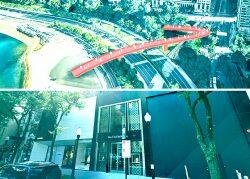As landlords deal with distressed debt and high vacancies on Chicago’s Magnificent Mile, the sale of the Neiman Marcus building may show investors and retailers the margins they need to be viable on Chicago’s most famous shopping strip.
Houston-based Silvestri Investments from UBS Realty Investors paid $94 million for the four-story building at 737 North Michigan Avenue, according to public records. That works out to just under $480 per square foot. Meanwhile, the store was on track to record sales of $629 per square foot in 2021, according to a marketing brochure for the property, and was likely boosted by the closure of similar stores as it absorbed some of their customers.
The sale’s price per square foot is lower than many achieved on the Mag Mile, as rents for new deals averaged $550 per square foot in 2017. Yet because the buyer has a reputation as a retail landlord rather than a developer and financed its purchase with a seven-year loan, it hints Neiman Marcus is staying and likely renewed a lease for at least five more years sometime fairly recently, said Cushman & Wakefield broker Greg Kirsch, who wasn’t involved in the deal.
“As a general rule, the capital acquiring assets on the Mag Mile five to eight years ago anticipated rent escalation to eventually hit $750 a foot,” Kirsch said. “Unfortunately, that trend didn’t materialize.”
If Neiman really is staying in the 196,000 square-foot building, after its peers including Macy’s and Gap left big Mag Mile stores during the pandemic, it means rents are coming down from investors’ expectations of the mid-2010s. As investors and sellers’ expectations move closer together, that should resolve the shopping strip’s occupancy woes. Mag Mile vacancies were at 25 percent earlier this year, Cushman found, up from 12 percent in 2018.
The pandemic exacerbated the vacancies as foot traffic plunged, surprising investors who had made big bets on retail rents rising and many were unable or unwilling to lower rents to levels tolerable to would-be tenants in the post-pandemic shopping world.
“So many owners are stuck and can’t execute below their pro-forma,” Kirsch said.
The north end of the Mag Mile, just north of the Neiman Marcus building, has been especially distressed, with the owner of the Water Tower Place vertical mall set to hand the keys back to its lender. On the other end of the street, retail landlord Macerich also sold its 50 percent stake in The Shops at North Bridge building for $21 million, a fraction of the $515 million that it and its partner, the Alaska Permanent Fund, paid in 2008. In between, other Mag Mile properties are healthy.
The high variance of financial situations faced by landlords on the Mag Mile was also viewed as an obstacle to implementing a cohesive revival strategy on the retail strip by a panel of experts convened by the Urban Land Institute.
“Co-tenancy has really suffered,” Max Meyer, a member of the panel, said. “Juxtaposed with that, you have disparate owners with different financial conditions and it’s very hard to get kind of a cohesive approach to what tenancy should look like.”
Replicating some of the retail strategies that have yielded success just around the corner from Michigan Avenue on Oak Street, at the Mag Mile’s north end, is also among the recommendations of the Urban Land Institute experts. They suggested boutique-type stores and brands unique to Chicago could become tenants beside small-scale luxury stores between the Drake Hotel and 875 North Michigan Avenue, formerly called the John Hancock Center.
“This is an interesting pivot we’re in the middle of,” said Kirsch, “While some extraneous Mag Mile space should be decommissioned as retail, there are a lot of different uses that want to be on the street but can’t afford to yet. We’re just working through another market cycle that appears dramatic, but people forget history and how long it took to recover from the 2008 financial crisis. This too, shall pass.”
Read more


